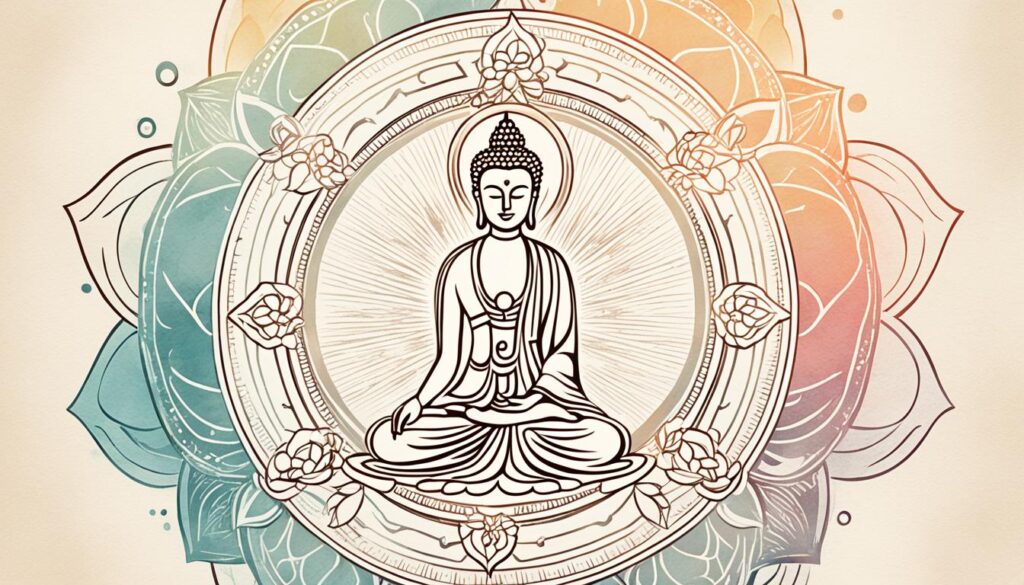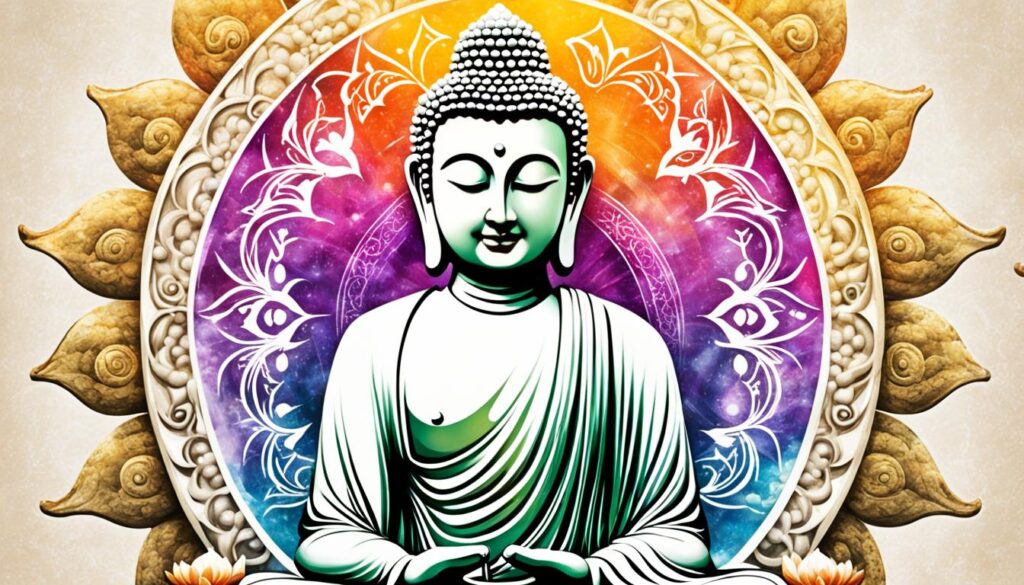Have you ever wondered what it truly means to achieve inner peace and liberation from suffering? In the practice of Buddhism, there is a concept that holds the answer – Nirvana. But what exactly is Nirvana in Buddhism? Is it just a symbol or does it have a deeper meaning? Join us on a journey to uncover the secrets of Nirvana in Buddhism and discover how it can guide you towards a path of ultimate peace and enlightenment.
Key Takeaways:
- Nirvana is a central concept in Buddhism, representing the ultimate goal of achieving inner peace and liberation from suffering.
- In Buddhism, Nirvana is symbolized by the extinguishing of the three fires of craving, ignorance, and aversion.
- Nirvana is not a place or a state of annihilation; rather, it is a state of complete peace, freedom, and enlightenment.
- The path to Nirvana involves understanding and accepting the truth of suffering and following the Eightfold Path.
- Mindfulness and compassion are key components of the Buddhist path to Nirvana, helping individuals cultivate inner peace and overcome negative emotions.
Understanding Nirvana in Buddhism
In Buddhism, nirvana holds profound significance as it represents the ultimate goal of spiritual practice – liberation from the cycle of birth and death, known as samsara. It is the state of complete peace, freedom, and enlightenment that is attained by realizing the Four Noble Truths and following the Eightfold Path.
Nirvana is not a physical place or a state of annihilation; it is far from that. Instead, it is a transcendental state of utmost clarity and wisdom. By reaching nirvana, one experiences the cessation of suffering and attains profound insight into the nature of reality.
The journey towards nirvana begins with understanding and accepting the Four Noble Truths, which reveal the truth of suffering, its causes, and the path to its cessation. These truths form the foundation for spiritual transformation in Buddhism. Following this, practitioners embark on the Eightfold Path, which encompasses right view, right intention, right speech, right action, right livelihood, right effort, right mindfulness, and right concentration. This path provides a comprehensive framework for ethical conduct, mental cultivation, and wisdom.
By diligently following the teachings of the Buddha, individuals gradually transcend the limitations of their conditioned existence and uncover a deep sense of peace and freedom within themselves. Nirvana becomes a reality as they break free from ignorance, desire, and attachment, and come to know the truth of their own being.
Realizing the Four Noble Truths
The Four Noble Truths serve as the guiding principles for understanding suffering and its cessation:
- Dukkha: The truth of suffering. It acknowledges the existence of suffering in various forms, such as physical pain, emotional distress, and dissatisfaction with life.
- Samudaya: The truth of the origin of suffering. It highlights the role of desire, attachment, and ignorance as the causes of suffering.
- Nirodha: The truth of the cessation of suffering. It reveals that the state of nirvana is attainable by eliminating craving and clinging and reaching a state of liberation and peace.
- Magga: The truth of the path to the cessation of suffering. It lays out the Eightfold Path as the means to realize nirvana and free oneself from the cycle of birth and death.
Following the Eightfold Path
The Eightfold Path serves as a roadmap for practitioners on their journey towards nirvana:
| Eightfold Path | Description |
|---|---|
| Right View | Gaining a correct understanding of the nature of reality and the Four Noble Truths. |
| Right Intention | Cultivating intentions free from greed, hatred, and delusion. |
| Right Speech | Engaging in truthful, kind, and harmonious communication. |
| Right Action | Behaving ethically and avoiding harming oneself and others. |
| Right Livelihood | Choosing a livelihood that is honorable, non-harmful, and supports the path to liberation. |
| Right Effort | Exerting oneself in cultivating wholesome qualities and abandoning unwholesome ones. |
| Right Mindfulness | Developing present-moment awareness and deep insight into the nature of reality. |
| Right Concentration | Cultivating focused and tranquil states of mind through meditation. |
By diligently practicing the Eightfold Path, individuals purify their minds, transform their consciousness, and ultimately achieve the state of nirvana.
The Path to Nirvana
Buddhism teaches you how to move towards the ultimate goal of nirvana. This path involves understanding and accepting the truth of suffering, recognizing the causes of suffering, and following the Eightfold Path to overcome it.
The Four Noble Truths, which form the foundation of the Buddha’s teachings, guide you towards liberation from suffering. These truths reveal the existence of suffering, its causes, its cessation, and the path to its cessation.
The Eightfold Path serves as a roadmap for living a moral, mindful, and purposeful life. It consists of eight interconnected aspects:
- Right View: Developing an accurate understanding of the nature of reality.
- Right Intention: Cultivating wholesome intentions and renouncing harmful desires.
- Right Speech: Speaking truthfully, kindly, and without causing harm.
- Right Action: Engaging in ethical conduct and refraining from harming others.
- Right Livelihood: Earning a living in a way that is honorable and free from harm.
- Right Effort: Cultivating wholesome qualities and abandoning unwholesome ones.
- Right Mindfulness: Developing moment-to-moment awareness and clear comprehension.
- Right Concentration: Cultivating a focused and concentrated mind through meditation.
By following the Eightfold Path, you can gradually purify your mind, overcome suffering, and move closer to the state of nirvana.
The Eightfold Path in Buddhism
| Aspect | Description |
|---|---|
| Right View | Developing an accurate understanding of the nature of reality. |
| Right Intention | Cultivating wholesome intentions and renouncing harmful desires. |
| Right Speech | Speaking truthfully, kindly, and without causing harm. |
| Right Action | Engaging in ethical conduct and refraining from harming others. |
| Right Livelihood | Earning a living in a way that is honorable and free from harm. |
| Right Effort | Cultivating wholesome qualities and abandoning unwholesome ones. |
| Right Mindfulness | Developing moment-to-moment awareness and clear comprehension. |
| Right Concentration | Cultivating a focused and concentrated mind through meditation. |
The Eightfold Path provides a practical and transformative framework for your journey towards spiritual development, self-realization, and the attainment of nirvana.

The Role of Mindfulness and Compassion
Mindfulness and compassion are integral components of the Buddhist path to nirvana. Throughout the practice of Buddhism, these qualities play a crucial role in cultivating inner peace, overcoming negative emotions, and ultimately attaining enlightenment.
Mindfulness involves being fully present and aware of our thoughts, feelings, and sensations in the present moment. It is a state of heightened attention and non-judgmental awareness. By practicing mindfulness, you can develop a deep understanding of your own mind and experiences, enhancing your ability to respond to life’s challenges with clarity and equanimity.
Compassion, on the other hand, encompasses a deep concern for the well-being and happiness of all living beings. It is a quality of heart that extends love, kindness, and understanding to oneself and others. By cultivating compassion, you can cultivate a sense of interconnectedness and foster harmonious relationships with those around you.

Both mindfulness and compassion work hand in hand on the Buddhist path. Mindfulness helps you develop the ability to observe your own thoughts, emotions, and actions without judgment, leading to greater self-acceptance and understanding. This self-awareness serves as a foundation for cultivating compassion, as it enables you to recognize the common human experience of suffering and respond to it with empathy and kindness.
Through the practice of mindfulness and compassion, you can transcend negative emotions such as anger, greed, and hatred. They allow you to cultivate positive qualities such as love, kindness, and generosity, which are essential for spiritual growth and enlightenment.
By incorporating mindfulness and compassion into your daily life, you will not only enhance your own well-being but also contribute to the well-being and happiness of others. This transformative journey towards inner peace and enlightenment is at the core of the Buddhist teachings on mindfulness and compassion.
Applying Buddhist Teachings to Modern Challenges
Buddhism offers invaluable teachings that can guide individuals in navigating the complexities of modern society. By incorporating Buddhist principles into daily life, you can address the challenges of the modern world and find greater peace and harmony.
Mindfulness: The fast-paced nature of modern life often leaves us feeling overwhelmed and disconnected. Buddhism emphasizes the practice of mindfulness, which involves being fully present in the moment and cultivating awareness of our thoughts, emotions, and sensations. By practicing mindfulness, you can reduce stress, alleviate anxiety, and regain a sense of balance and clarity.
Compassion: In today’s fragmented and individualistic society, fostering a sense of empathy and interconnectedness is essential. Buddhist teachings on compassion inspire us to extend kindness and care not only to ourselves but also to others. By cultivating compassion, you can build meaningful connections, enhance your relationships, and contribute to the well-being of society as a whole.
Ethical Principles: Buddhism advocates for ethical conduct, emphasizing values such as nonviolence, honesty, and kindness. These principles provide a moral compass that can guide individuals and societies towards greater harmony and wellbeing. By practicing nonviolence, both in actions and words, you can contribute to a more peaceful and compassionate world.
Bringing Buddhism teachings into the modern context can positively impact the challenges we face today. By incorporating mindfulness, compassion, and ethical principles, we can navigate the complexities of the modern world with greater wisdom, peace, and understanding.

| Modern Challenges | Buddhist Teachings |
|---|---|
| Stress and Anxiety | Mindfulness offers techniques to manage stress and anxiety, promoting inner calm and mental clarity. |
| Individualism | Compassion encourages a sense of interconnectedness, fostering empathy and promoting harmonious relationships. |
| Violence and Conflict | Buddhist ethical principles advocate nonviolence, promoting peace and reducing conflicts in society. |
Overcoming Mental Dysfunction and Finding Inner Peace
Buddhism teaches that inner peace and happiness can be attained by overcoming mental dysfunction and cultivating a peaceful mind. By recognizing the causes of suffering, such as attachment and ignorance, you can develop the wisdom and insight needed to transform your mind.
One powerful tool in this journey is the practice of meditation. Meditation allows you to quiet the mind, let go of past regrets and future preoccupations, and fully embrace the present moment. Through meditation, you can cultivate a deep sense of inner peace and tranquility.
The Practice of Meditation
Meditation involves training your mind to focus and redirect your thoughts. By practicing meditation regularly, you can develop mindfulness and concentration, which are essential for overcoming mental distractions and finding peace of mind.
Here are some simple steps to start your meditation practice:
- Find a quiet and comfortable space where you can sit or lie down.
- Close your eyes and take a few deep breaths to relax your body and mind.
- Focus your attention on your breath, observing the sensations of the inhale and exhale.
- Whenever your mind starts to wander, gently bring your attention back to your breath without judgment.
- Continue this practice for a few minutes, gradually increasing the duration as you become more comfortable.
Through consistent meditation practice, you can cultivate a peaceful and stable mind, free from mental clutter and distractions. This state of calmness allows you to experience a deep sense of happiness and contentment.

The Benefits of Cultivating Inner Peace
When you overcome mental dysfunction and find inner peace, you unlock a wealth of benefits in your life:
- Increased Happiness: Inner peace brings a profound sense of joy and contentment, allowing you to experience true happiness.
- Reduced Stress and Anxiety: By cultivating a peaceful mind, you can alleviate stress and anxiety, leading to improved overall well-being.
- Improved Clarity and Focus: Inner peace enhances your ability to concentrate, make decisions, and navigate life with clarity and purpose.
- Enhanced Relationships: When you find peace within yourself, you can foster healthier and more compassionate relationships with others.
- Greater Resilience: Inner peace gives you the strength and resilience to face life’s challenges with equanimity and grace.
By incorporating the principles of Buddhism into your life, including mindfulness, compassion, and ethical conduct, you can cultivate a peaceful mind and experience true happiness and fulfillment.
| Benefits of Cultivating Inner Peace | Description |
|---|---|
| Increased Happiness | Experience profound joy and contentment |
| Reduced Stress and Anxiety | Alleviate stress and anxiety for improved well-being |
| Improved Clarity and Focus | Enhance concentration, decision-making, and life navigation |
| Enhanced Relationships | Foster healthier and more compassionate relationships |
| Greater Resilience | Face life’s challenges with equanimity and grace |
The Three Jewels of Buddhism
In Buddhism, the Three Jewels, also known as the Triratna, are the cornerstone of Buddhist philosophy and practice. They represent the essential elements that guide followers on the path to enlightenment and liberation from suffering. The Three Jewels consist of the Buddha, the Dharma, and the Sangha.
The Buddha: The Enlightened One
The first jewel of Buddhism is the Buddha. Siddhartha Gautama, the historical figure who later became known as the Buddha, lived in the 5th century BCE. After years of spiritual seeking and rigorous practice, he attained enlightenment under the Bodhi tree. The Buddha serves as a guide and inspiration for all those on the spiritual journey, showcasing the possibilities of awakening and the transformation of consciousness.
The Dharma: The Teachings of the Buddha
The second jewel is the Dharma, which refers to the teachings of the Buddha. These teachings form the framework for living an ethical and meaningful life. The Dharma encompasses the Four Noble Truths, which explain the nature of suffering and its causes, and the Eightfold Path, which provides guidance on moral conduct, mindfulness, and wisdom. Through the Dharma, individuals gain insight into the true nature of reality and discover the path to liberation.
The Sangha: The Community of Practitioners
The third jewel is the Sangha, which represents the community of Buddhist practitioners. The Sangha provides support, inspiration, and guidance on the spiritual path. It comprises both monastic and lay followers who come together to practice and support one another’s journeys. The monastic Sangha consists of monks and nuns who have dedicated their lives to the study and practice of the Dharma. The lay Sangha includes individuals who integrate Buddhist teachings into their everyday lives while maintaining their societal roles.
| Jewel | Role |
|---|---|
| Buddha | Enlightened teacher and role model |
| Dharma | Guidance for ethical conduct and spiritual development |
| Sangha | Supportive community of practitioners |

The Three Jewels of Buddhism form the foundation of the Buddhist path, offering guidance, inspiration, and support to those seeking progress on their spiritual journeys. By taking refuge in the Three Jewels, individuals commit themselves to the pursuit of awakening and the liberation from suffering.
The Buddha: Founder of the Awakening Teaching
Siddhartha Gautama, also known as the Buddha, is revered as the founder of Buddhism. He lived in the 5th century BCE in present-day Nepal. The Buddha embarked on a profound journey towards enlightenment, prompted by his realization of the pervasive suffering in the world. After years of rigorous training and deep meditation, he achieved a state of awakening and became known as the Buddha, or “The Enlightened One.”
The Buddha’s teachings, known as the Awakening Teaching or Dharma, provide profound guidance for individuals seeking liberation from suffering and the attainment of inner peace. Through his profound insights and compassionate teachings, the Buddha illuminated the path to enlightenment and inspired countless followers to embark on their own transformative journeys.

At the heart of the Buddha’s teachings is the understanding that suffering is an inherent part of life, but it can be transcended through the eradication of ignorance and the cultivation of wisdom, compassion, and mindfulness. The Buddha’s teachings offer practical methods and ethical principles that can be applied to everyday life, enabling individuals to transform their minds and find lasting peace and fulfillment.
The Journey to Enlightenment
The Buddha’s path to enlightenment was marked by immense dedication and unwavering commitment. He renounced his privileged life as a prince and embarked on a spiritual quest to find the truth of existence and alleviate the suffering of humanity. Through rigorous ascetic practices and deep meditation, the Buddha transcended the limitations of the human condition and awakened to the ultimate reality.
Upon attaining enlightenment, the Buddha began sharing his teachings with others, offering a path to liberation from suffering and the realization of inner peace. His profound wisdom, compassion, and transformative teachings resonate to this day, inspiring seekers from all walks of life to cultivate mindfulness, compassion, and wisdom on their own spiritual journeys.
The Legacy of the Buddha
The Buddha’s teachings continue to resonate with millions of people around the world, offering profound insights into the nature of existence and providing practical guidance for living a meaningful and fulfilling life. His teachings have transcended time and cultural boundaries, inspiring individuals to question the nature of reality, find solace amidst adversity, and seek liberation from suffering.
Through his teachings, the Buddha emphasized the importance of personal experience and direct realization. He emphasized that true liberation could only be attained through individual effort and self-transformation. The Buddha’s teachings have thus empowered generations to explore their own inner landscape and awaken to their divine potential.
The Buddha’s legacy is not only found in his teachings but also in the Sangha, the community of practitioners who continue to embody and propagate his teachings. Monastic and lay practitioners alike draw inspiration from the Buddha’s example, dedicating their lives to the pursuit of enlightenment and sharing the wisdom of the Dharma with others.
The Dharma: The Path of Righteousness
The Dharma is the embodiment of the Buddha’s teachings and represents the path of righteousness for those seeking enlightenment and nirvana. It encompasses the Four Noble Truths and the Eightfold Path, providing a comprehensive framework for leading a virtuous and meaningful life.
The Four Noble Truths
- Dukkha: The truth of suffering
- Samudaya: The truth of the origin of suffering
- Nirodha: The truth of the cessation of suffering
- Magga: The truth of the path leading to the cessation of suffering
The Four Noble Truths reveal the nature of suffering and its causes, guiding individuals to understand and overcome the cycle of suffering in their lives. It is through this understanding that the path to liberation and ultimate peace, known as nirvana, can be realized.
The Eightfold Path
- Right View: Understanding the true nature of reality
- Right Intention: Cultivating wholesome intentions and motivations
- Right Speech: Speaking truthfully, kindly, and mindfully
- Right Action: Acting in ways that promote harmony, compassion, and non-harming
- Right Livelihood: Choosing an ethical and compassionate means of livelihood
- Right Effort: Cultivating wholesome qualities and eliminating unwholesome ones
- Right Mindfulness: Developing a non-judgmental awareness of the present moment
- Right Concentration: Cultivating focused and undisturbed mental states through meditation
The Eightfold Path provides a roadmap for ethical conduct, mental cultivation, and wisdom. Each aspect of the path is interdependent and supports the others, leading individuals towards a life of righteousness and inner transformation.

The Dharma serves as a profound guide for living a virtuous and meaningful life, leading to the liberation from suffering and the attainment of enlightenment. By embracing the Four Noble Truths and the Eightfold Path, individuals can embark on a transformative journey towards ultimate peace and liberation.
The Sangha: The Community of Followers
The Sangha is the community of dedicated individuals who follow the teachings of the Buddha. It is a diverse community that includes both monastic and lay practitioners, each contributing to the spiritual growth and development of its members.
The Monastic Sangha:
The monastic Sangha consists of monks and nuns who have chosen to devote their lives to the practice and propagation of the Dharma. They embrace a simple and disciplined lifestyle, renouncing worldly attachments to focus on their spiritual journey. Monastic practitioners live in monasteries or nunneries, upholding the highest standards of ethical conduct, meditation, and study. They provide a source of inspiration and guidance for lay followers, embodying the core principles of the Buddhist teachings.
The Lay Sangha:
The lay Sangha comprises individuals who strive to integrate Buddhist principles into their everyday lives. These practitioners engage in regular spiritual practices, such as meditation and mindfulness, while leading household lives. Lay followers support the monastic community by offering donations, participating in communal activities, and seeking guidance from monastic practitioners. They play a vital role in creating a harmonious and supportive environment for the entire Sangha.
Together, the Sangha forms a close-knit community that fosters spiritual growth and development. By sharing wisdom, supporting one another, and upholding the values of compassion and mindfulness, the Sangha cultivates an atmosphere of unity and encouragement on the path towards enlightenment.

| Type of Sangha | Description | Role |
|---|---|---|
| Monastic Sangha | Composed of monks and nuns who renounce worldly attachments to commit to spiritual practice | Provide inspiration and guidance for the lay Sangha |
| Lay Sangha | Consists of individuals who integrate Buddhist principles into their everyday lives | Support the monastic Sangha and participate in communal activities |
By embracing the teachings of the Buddha, both monastic and lay Sangha members contribute to their personal growth and the spiritual well-being of the entire community. Together, they create a supportive and nurturing environment for individuals seeking the path to inner peace and liberation.
Taking Refuge in the Three Jewels
When embarking on the path of Buddhism, taking refuge in the Three Jewels is a significant and formal step. It represents a profound commitment to the Buddhist teachings and signifies a deep desire to attain inner peace and liberation from suffering.
Taking refuge involves placing your faith and seeking guidance, protection, and support in the Three Jewels: the Buddha, the Dharma, and the Sangha. Each Jewel has a unique role to play in your spiritual journey.
The Buddha: Enlightened Guide
The first Jewel, the Buddha, is the historical figure of Siddhartha Gautama. He attained enlightenment through deep introspection and profound insight, becoming the awakened one. Taking refuge in the Buddha means placing your trust in his teachings and using him as a role model for spiritual awakening.
The Dharma: Path to Liberation
The second Jewel, the Dharma, encompasses the teachings of the Buddha. Taking refuge in the Dharma means embracing and practicing the Four Noble Truths and the Eightfold Path. The Dharma provides the guidance and wisdom needed to overcome suffering and achieve liberation. It is the path to righteousness and enlightenment.
The Sangha: Community of Support
The third Jewel, the Sangha, refers to the community of fellow practitioners. Taking refuge in the Sangha means becoming part of a supportive network of individuals who share the same aspirations and values. The Sangha provides companionship, encouragement, and inspiration on your spiritual journey.
Taking refuge in the Three Jewels grants you a spiritual security that accompanies your dedication to the Buddhist path. It provides a solid foundation for your practice and offers a sense of belonging to a community of like-minded individuals. By seeking guidance and support from the Buddha, the Dharma, and the Sangha, you embark on a transformative journey towards inner peace, liberation from suffering, and profound spiritual awakening.
Taking refuge in the Three Jewels is a powerful declaration of your commitment to following the path of enlightenment and abiding by the teachings of the Buddha. It serves as a constant reminder that you are not alone on your journey and that the wisdom of the Three Jewels will guide and support you every step of the way.
| Jewel | Meaning |
|---|---|
| The Buddha | Enlightened guide and role model |
| The Dharma | Path to liberation and enlightenment |
| The Sangha | Community of fellow practitioners for support |

Conclusion
Buddhism offers profound teachings and practices for attaining inner peace, freedom from suffering, and spiritual awakening. Through understanding the concept of nirvana, following the path of the Four Noble Truths and the Eightfold Path, and taking refuge in the Three Jewels, you can embark on a transformative journey towards ultimate peace and liberation.
By embracing mindfulness, compassion, and ethical conduct, you have the power to cultivate a peaceful mind, overcome mental dysfunction, and find lasting happiness and contentment. The teachings of Buddhism provide valuable insights and tools that can be applied to the challenges of modern life, guiding you towards personal and societal harmony.
With Buddhism as your guide, you have the opportunity to transcend suffering, achieve enlightenment, and experience the profound bliss of nirvana. The path may not always be easy, but the rewards are immeasurable. So, take refuge in the teachings of the Buddha, embark on this transformative journey, and discover the true meaning of inner peace and spiritual awakening.
FAQ
What is nirvana in Buddhism?
Nirvana in Buddhism is the ultimate goal of achieving inner peace and liberation from suffering. It represents a state of complete peace, freedom, and enlightenment.
What does nirvana symbolize in Buddhism?
Nirvana in Buddhism is symbolized by the extinguishing of the three fires of craving, ignorance, and aversion. It signifies the cessation of suffering and the attainment of enlightenment.
What is the meaning of nirvana in Buddhism?
In Buddhism, nirvana means “extinction” or “blowing out.” It refers to the cessation of suffering and the attainment of liberation from the cycle of birth and death.
What is the goal that Buddhism teaches people to move toward?
Buddhism teaches people to move toward the goal of nirvana, which is the ultimate state of liberation from suffering and the attainment of inner peace and enlightenment.
What is the role of mindfulness and compassion in Buddhism?
Mindfulness and compassion are integral components of the Buddhist path to nirvana. Mindfulness involves being fully present and aware, while compassion involves a deep concern for the well-being of all living beings.
How can Buddhist teachings be applied to modern challenges?
Buddhist teachings offer valuable insights and practices that can help individuals cope with stress, cultivate empathy, and promote harmony and wellbeing in modern society.
How can Buddhism help in overcoming mental dysfunction and finding inner peace?
Buddhism teaches individuals to cultivate a peaceful mind through practices like meditation, letting go of past regrets and future preoccupations, and living fully in the present moment.
What are the Three Jewels of Buddhism?
The Three Jewels of Buddhism are the Buddha, the Dharma (teachings of the Buddha), and the Sangha (community of followers). They form the foundation of Buddhist doctrine and practice.
Who is the founder of Buddhism?
Siddhartha Gautama, also known as the Buddha, is regarded as the founder of Buddhism. He achieved enlightenment and became the “Enlightened One.”
What is the Dharma in Buddhism?
The Dharma in Buddhism refers to the teachings of the Buddha. It provides guidance for moral conduct and spiritual development, including the Four Noble Truths and the Eightfold Path.
What is the Sangha in Buddhism?
The Sangha in Buddhism is the community of followers who adhere to the teachings of the Buddha. It includes both monastic and lay practitioners who support and inspire each other on the Buddhist path.
What does it mean to take refuge in the Three Jewels?
Taking refuge in the Three Jewels signifies a commitment to the Buddhist path. It involves seeking protection, guidance, and support in the Buddha, the Dharma, and the Sangha on the journey towards inner peace and liberation from suffering.
What does Buddhism teach about achieving inner peace and liberation?
Buddhism offers profound teachings and practices for attaining inner peace and liberation from suffering. By understanding the concept of nirvana, following the path of the Four Noble Truths and the Eightfold Path, and taking refuge in the Three Jewels, individuals can embark on a transformative journey towards ultimate peace and liberation.

